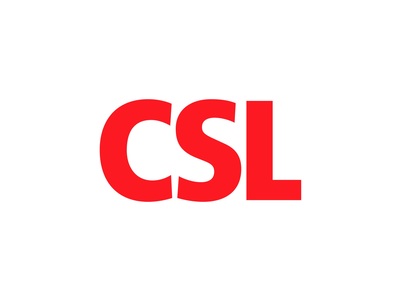- Long-term data from the pivotal HOPE-B study show a one-time infusion of HEMGENIX generated elevated and sustained mean factor IX levels and reduced the rate of annual bleeding
- 24-month results reinforced safety of treatment, with no serious treatment-related adverse effects related to HEMGENIX infusion
- HEMGENIX, recently approved by the U.S. Food and Drug Administration, is the first and only gene therapy for the treatment of certain adults living with hemophilia B
KING OF PRUSSIA, Pa., Dec. 10, 2022 /PRNewswire/ -- Global biotechnology leader CSL (ASX: CSL) today announced the presentation of data affirming the long-term durability and safety of single-infusion HEMGENIX® (etranacogene dezaparvovec-drlb) in the treatment of certain adults living with hemophilia B at the 64th American Society of Hematology (ASH) Annual Meeting. Results from the pivotal HOPE-B study, the largest gene therapy study in hemophilia B to date, demonstrated that after two years of follow-up, adults with severe or moderately severe hemophilia B treated with a one-time infusion of HEMGENIX generated elevated and sustained mean factor IX activity levels and durable hemostatic protection.
"Gene therapy has great potential for rare bleeding disorders, and these results demonstrate long-lasting increases in factor IX activity levels, reaching levels near the normal range seen in people without hemophilia B," said Steven Pipe, M.D., professor of pediatrics and pathology and pediatric medical director of the hemophilia and coagulation disorders program at the University of Michigan, and principal investigator of the HOPE-B pivotal trial. "These data reinforce that people with hemophilia B who have received HEMGENIX would likely achieve durable factor IX activity levels for years following a one-time infusion."
Key Data from the HOPE-B 24-Month Extension
In the open-label, single-arm HOPE-B study, 54 adult male participants with severe or moderately severe hemophilia B, with or without pre-existing AAV5 neutralizing antibodies were infused with a single dose of HEMGENIX. HEMGENIX produced mean factor IX activity of 39.0 IU/dL at six months and 36.9 IU/dL at 18 months post infusion, which was sustained at 36.7 IU/dL in the long-term follow-up data at two years. In addition, 94 percent (51 out of 54) of patients treated with HEMGENIX discontinued use of prophylaxis and remained free of previous continuous routine prophylaxis therapy.
In an abstract that CSL Behring will present, the data demonstrate the ABR for all bleeds was reduced by 64% during months 7-24 of the study (mean ABR 1.51 vs. 4.18 during the lead-in period; p=0.0002), sustaining the same bleed reduction that satisfied the study's primary endpoint. The FDA-approved prescribing information for HEMGENIX shows that ABR for all bleeds was reduced by 54% during months 7-18 of the study. Treatment with HEMGENIX also reduced mean unadjusted annualized factor IX consumption by 96% from the lead-in period (257,339 IU/year/participant) to months 19–24 (9751 IU/year/participant; p<0.0001).
Of the 557 treatment-emergent adverse events reported 24-months post-infusion, 424 (76%) were mild, 115 (21%) were moderate and 18 (3%) were severe. A total of 38 participants (70.4%) experienced 93 treatment-related adverse events, with only one occurring during months 18-24. There were no serious adverse effects related to treatment; a serious AE of hepatocellular carcinoma was determined by independent molecular genomic and integration analysis to be unrelated to treatment.
"The results presented at ASH continue to support the potential long-lasting efficacy and safety of HEMGENIX and the ongoing benefit of this treatment for people living with hemophilia B," said Brahm Goldstein, M.D., Vice President, Research and Development, Hematology at CSL. "HEMGENIX offers eligible people living with hemophilia B more choice in treatments and underscores CSL's promise to deliver disruptive innovations, like gene therapy, that have the potential to improve the lives of people living with rare and serious diseases in our therapeutic areas of focus, like hematology."
CSL presented two additional abstracts at the ASH Annual Meeting:
- Durability of Bleeding Protection and Factor IX Activity Levels Are Demonstrated in Individuals with and without Adeno-Associated Virus Serotype 5 Neutralizing Antibodies (Titers <1:700) with Comparable Safety in the Phase 3 HOPE-B Clinical Trial of Etranacogene Dezaparvovec Gene Therapy for Hemophilia B
- Durability of Factor IX Activity and Bleeding Rate in People with Severe or Moderately Severe Hemophilia B after 5 Years of Follow-up in the Phase 1/2 Study of AMT-060, and after 3 Years of Follow-up in the Phase 2b and 2 Years of Follow-up in the Phase 3 Studies of Etranacogene Dezaparvovec (AMT-061)
The multi-year clinical development program for HEMGENIX was led by uniQure (Nasdaq: QURE), and sponsorship of the clinical trials transitioned to CSL after it acquired global rights to commercialize the treatment. HEMGENIX is still currently under assessment by other regulatory agencies.
CSL medical representatives will be available at booth number 228 throughout the ASH Annual Meeting.
About Hemophilia B
Hemophilia B is a life-threatening rare disease. People with the condition are particularly vulnerable to bleeds in their joints, muscles, and internal organs, leading to pain, swelling, and joint damage. Current treatments for moderate to severe hemophilia B include life-long prophylactic infusions of factor IX to temporarily replace or supplement low levels of the blood-clotting factor.
About HEMGENIX
HEMGENIX is the first and only one-time gene therapy approved for the treatment of adults living with hemophilia B. HEMGENIX is approved for the treatment of adults with hemophilia B who currently use factor IX prophylaxis therapy, or have current or historical life-threatening hemorrhage, or have repeated, serious spontaneous bleeding episodes.
HEMGENIX is a gene therapy that reduces the rate of abnormal bleeding in eligible people with hemophilia B by enabling the body to continuously produce factor IX, the deficient protein in hemophilia B. It uses AAV5, a non-infectious viral vector, called an adeno-associated virus (AAV). The AAV5 vector carries the Padua gene variant of Factor IX (FIX-Padua) to the target cells in the liver, generating factor IX proteins that are 5x-8x more active than normal. These genetic instructions remain in the target cells, but generally do not become a part of a person's own DNA. Once delivered, the new genetic instructions allow the cellular machinery to produce elevated levels of factor IX.
About the Pivotal HOPE-B Trial
The pivotal Phase III HOPE-B trial is an ongoing, multinational, open-label, single-arm study to evaluate the safety and efficacy of HEMGENIX. Fifty-four adult hemophilia B patients classified as having moderately severe to severe hemophilia B and requiring prophylactic factor IX replacement therapy were enrolled in a prospective, six-month or longer observational period during which time they continued to use their current standard of care therapy to establish a baseline Annual Bleeding Rate (ABR). After the six-month lead-in period, patients received a single intravenous administration of HEMGENIX at the 2x10^13 gc/kg dose. Patients were not excluded from the trial based on pre-existing neutralizing antibodies (NAbs) to AAV5.
A total of 54 patients received a single dose of HEMGENIX in the pivotal trial, with 53 patients completing at least 18 months of follow-up. The primary endpoint in the pivotal HOPE-B study was ABR 52 weeks after achievement of stable factor IX expression (months 7 to 18) compared with the six-month lead-in period. For this endpoint, ABR was measured from month seven to month 18 after infusion, ensuring the observation period represented a steady-state factor IX transgene expression. Secondary endpoints included assessment of factor IX activity.
No serious adverse reactions were reported. One death resulting from urosepsis and cardiogenic shock in a 77-year-old patient at 65 weeks following dosing was considered unrelated to treatment by investigators and the company sponsor. A serious adverse event of hepatocellular carcinoma was determined to be unrelated to treatment with HEMGENIX by independent molecular tumor characterization and vector integration analysis. No inhibitors to factor IX were reported.
Important Safety Information (ISI)
What is HEMGENIX?
HEMGENIX®, etranacogene dezaparvovec-drlb, is a one-time gene therapy for the treatment of adults with hemophilia B who:
- Currently use Factor IX prophylaxis therapy, or
- Have current or historical life-threatening bleeding, or
- Have repeated, serious spontaneous bleeding episodes.
HEMGENIX is administered as a single intravenous infusion and can be administered only once.
What medical testing can I expect to be given before and after administration of HEMGENIX?
To determine your eligibility to receive HEMGENIX, you will be tested for Factor IX inhibitors. If this test result is positive, a retest will be performed 2 weeks later. If both tests are positive for Factor IX inhibitors, your doctor will not administer HEMGENIX to you. If, after administration of HEMGENIX, increased Factor IX activity is not achieved, or bleeding is not controlled, a post-dose test for Factor IX inhibitors will be performed.
HEMGENIX may lead to elevations of liver enzymes in the blood; therefore, ultrasound and other testing will be performed to check on liver health before HEMGENIX can be administered. Following administration of HEMGENIX, your doctor will monitor your liver enzyme levels weekly for at least 3 months. If you have preexisting risk factors for liver cancer, regular liver health testing will continue for 5 years post-administration. Treatment for elevated liver enzymes could include corticosteroids.
What were the most common side effects of HEMGENIX in clinical trials?
In clinical trials for HEMGENIX, the most common side effects reported in more than 5% of patients were liver enzyme elevations, headache, elevated levels of a certain blood enzyme, flu-like symptoms, infusion-related reactions, fatigue, nausea, and feeling unwell. These are not the only side effects possible. Tell your healthcare provider about any side effect you may experience.
What should I watch for during infusion with HEMGENIX?
Your doctor will monitor you for infusion-related reactions during administration of HEMGENIX, as well as for at least 3 hours after the infusion is complete. Symptoms may include chest tightness, headaches, abdominal pain, lightheadedness, flu-like symptoms, shivering, flushing, rash, and elevated blood pressure. If an infusion-related reaction occurs, the doctor may slow or stop the HEMGENIX infusion, resuming at a lower infusion rate once symptoms resolve.
What should I avoid after receiving HEMGENIX?
Small amounts of HEMGENIX may be present in your blood, semen, and other excreted/secreted materials, and it is not known how long this continues. You should not donate blood, organs, tissues, or cells for transplantation after receiving HEMGENIX.
Please see full prescribing information for HEMGENIX.
You are encouraged to report negative side effects of prescription drugs to the FDA. Visit www.fda.gov/medwatch, or call 1-800-FDA-1088.
You can also report side effects to CSL Behring's Pharmacovigilance Department at 1-866-915-6958.
About CSL
CSL (ASX:CSL; USOTC:CSLLY) is a leading global biotechnology company with a dynamic portfolio of lifesaving medicines, including those that treat hemophilia and immune deficiencies, vaccines to prevent influenza, and therapies in iron deficiency, dialysis and nephrology. Since our start in 1916, we have been driven by our promise to save lives using the latest technologies. Today, CSL – including our three businesses, CSL Behring, CSL Seqirus and CSL Vifor – provides lifesaving products to patients in more than 100 countries and employs 30,000 people. Our unique combination of commercial strength, R&D focus and operational excellence enables us to identify, develop and deliver innovations so our patients can live life to the fullest. For inspiring stories about the promise of biotechnology, visit CSLBehring.com/Vita and follow us on Twitter.com/CSL.
For more information about CSL, visit CSL.com.
Media Contacts
Maria Tortoreto
R&D Communications
Mobile: +1 201 248 5208
Email: maria.tortoreto@cslbehring.com
Etanjalie Ayala
Commercial Operations Communications
Mobile: +1 610 297 1069
Email: etanjalie.ayala@cslbehring.com
SOURCE CSL




